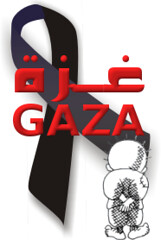More than One S in Resistance
| by Nadia Hijab | Released: 10 Aug 2009 |
The American administration is hoping that this week’s Fatah conference will strengthen their peace partner, but Palestinian reactions have been mixed. Some have expressed anger that the conference is being held under Israeli occupation and hence control. Others are disinterested, having long ago lost faith in the leadership on all sides. And a third group is hopeful that a Fatah phoenix will arise from the ashes of incompetence to lead the struggle for freedom and nationhood.
Much has been made of the fact that both the opening statement by Mahmoud Abbas – who heads the Palestine Liberation Organization, the Palestinian Authority and Fatah – and the new Fatah political program do not relinquish the armed struggle but favor popular, non-violent resistance.
As I have argued before, the armed struggle is the least effective source of power available to the Palestinians. Yes, it is legitimate under international law for people living under military occupation to take up armed resistance, so long as the tactics chosen do not violate those laws. But the Palestinian situation is very different to that of other guerrilla struggles that succeeded against superior forces. This does not mean that Palestinians should give up their arms. They do provide a deterrent, however modest, and an irritant to the established order.
Yet the question of whether the struggle is armed or not is a distraction from the real issues. There is more than one S in resistance, and any party that wants to lead the Palestinian national movement needs to recognize that resistance must be strategic, solidly based, and sustained towards a clear set of goals.
Popular resistance is potentially strategic, as was demonstrated during the first Intifada. But to fulfil its potential, it cannot be limited to parts of Palestinian society, such as villagers directly threatened by Israel’s separation wall, while others go about their business as usual. The entire people must be mobilized, and the leadership needs to be visible in -- indeed lead -- such demonstrations and protests.
To take just one recent example, many Palestinians wondered why their leaders did not act more forcefully to prevent Israel’s cruel eviction of families from their homes in Arab East Jerusalem last week. Had senior Palestinian officials sat with the families, would Israel have dragged them out along with over 50 people, 19 of them children? The unprotected families were forced into homelessness, and heart-breaking images were transmitted around the world -- like that of the middle-aged man seated on the ground surrounded by his belongings and wiping his tears with the back of his hand.
And another thing: If popular resistance is to succeed, the role of the American-trained Palestinian security would need to be revisited. At a minimum, they cannot be used to cow or crush such resistance, as happened during protests by West Bank Palestinians when Israel assaulted Gaza this winter.
Another strategic form of resistance is economic resistance, and in fact Palestinian Prime Minister Salam Fayyad has tried his hand at this. In 2008, he called on the European Union not to upgrade relations with Israel unless it agreed to a settlement freeze. This was ultimately unsuccessful: The European Union decided to go ahead with the upgrade, although it suspended it after Israel’s attack on Gaza.
Palestinian civil society and the international solidarity movement have shown that boycott and divestment are powerful non-violent, economic tools in the struggle for freedom and justice. How much more powerful such tools would be if a Palestinian leadership also called for boycott, divestment, and sanctions (BDS) so that the entire people spoke with one voice and reinforced each other’s efforts.
To be successful, a Palestinian resistance movement would also need to be grounded in a solid base. An effective leadership would address and overcome not only the fragmentation of the Palestinian body politic into Fatah and Hamas, but would also reach beyond the occupied territories and mobilize Palestinian refugees and exiles.
And, while it could not and should not represent the Palestinian citizens of Israel, a smart leadership would actively support their struggle for equal rights, holding this banner aloft for the Palestinian movement itself and explaining why, although it does recognize Israel, it could never recognize it as a Jewish state.
In addition, a resistance movement must be sustained -- it cannot be switched on and off like a tap. It takes a long time to mobilize people: The first Intifada was the culmination of over a decade of grassroots activism and popular mobilization. The international movement of solidarity was also built up over many years. Both were allowed to dissipate after the Oslo Accords. National and international grassroots activism is now being rebuilt, and a wise leadership would nourish and reinforce it.
Finally, the years of attempted deal-making behind closed doors have left the Palestinians and their supporters unsure about what they are fighting for. Palestinian civil society addressed this gap by setting out a compelling statement of goals in its July 2005 Call for BDS. The new Fatah political program has also restated its goals. If it wants to be effective, it must clearly and repeatedly articulate its goals -- and back them by a realistic strategy, a solid base, and sustained action. Otherwise, the Palestinian phoenix will arise elsewhere.
Nadia Hijab is an independent analyst and a senior fellow at the Institute for Palestine Studies.
Copyright © 2009 Nadia Hijab – distributed by Agence Global












